- Home
- Palm Physique
- Fruit of Palms
Fruit From Palm Trees
Fruit from palm trees comes in amazing assorted varieties!
Every palm, at some time or another produces fruits. There's a stunning variety of them! And some are quite delicious.
No doubt you've heard of the well-known coconut and perhaps the date. Did you know the date is a palm tree fruit? Most people think of palm trees for their connection with tropical climates & unique looks. And not for their fruit.
But we're here to show you these palm fruits. And how versatile they can be. Use our Contents below, or just scroll down to see them all.
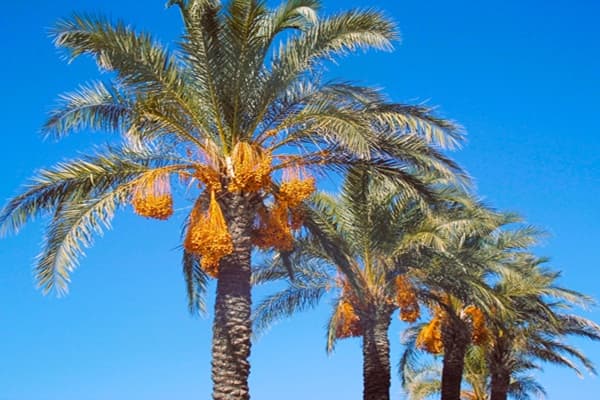 Date Palm trees with their fruit - Dates ready for harvest.
Date Palm trees with their fruit - Dates ready for harvest.What Are Fruits From Palm Trees?
Fruit from palm trees are the seeded fruits produced by different palm species.
- Some, like coconuts, dates, and acai, are edible and highly valued.
- Many others are inedible for people, but can be used for livestock feed.
- Wildlife also use fruit from palms as a source of food.
Fruits from a palm tree can be classified as: the good, the bad & the ugly!! From sweet & juicy, to tart, tangy, bitter & inedible.
- Think of that favorite of edible fruits: The Coconut!
- Or one that's not well-known for eating, But It's edible!
Let's see the different types of fruit from palm trees. We'll take you to a selection of the edible, the questionable & the awful/don't eat 'em!

Mission: Palm Trees is made possible by readers like you! If you purchase via a link/ ad here, we may earn a small commission. At no added cost to you. Thanks for your support! Learn more>
How Do Palm Trees Produce Fruit?
Palm tree fruit is the absolute for continuation of these tropical palm plants. Why?
Have you looked up at a palm tree, wondering about those small, puzzling clusters of solid balls hanging from its branches? Those are the palm's fruits!
They hold the key to the palm tree's survival.
From Palm Flowers to Palm Fruit
First comes the palm flower.
Each palm tree flower is almost always tiny and low-key. When you notice them above, on a palm, you may wonder - those things hanging there, are they flowers??
Yes they are! Growing on a stalk called an inflorescence. Whether on a Dioecious or Monoecious Palm, the infructescence holds the fruit until it ripens. Even though the flowers are small, the large inflorescence won't be missed.
The flowers' purpose is producing the seed-bearing fruit. Once fruit develops, you'd probably notice them on some palms. Because they've got a more showy display. On the branch now called the infructescence.
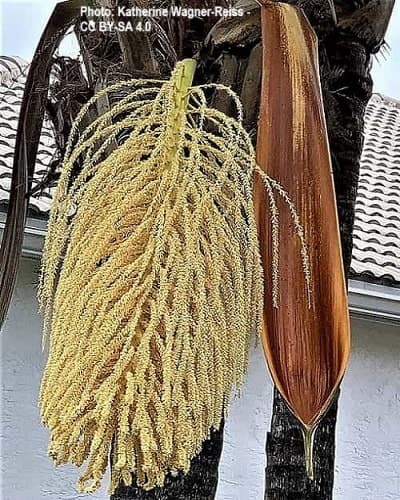 Palm flowers, often small,
play the role of producing palm tree fruit.
Palm flowers, often small,
play the role of producing palm tree fruit.Like other flowering plants, palm trees need a little romance to create the next generation. By using surrogates from nature!
Palms depend on wind, bees, or other insects for pollination. Once pollinated, flowers begin developing into palm tree fruit.
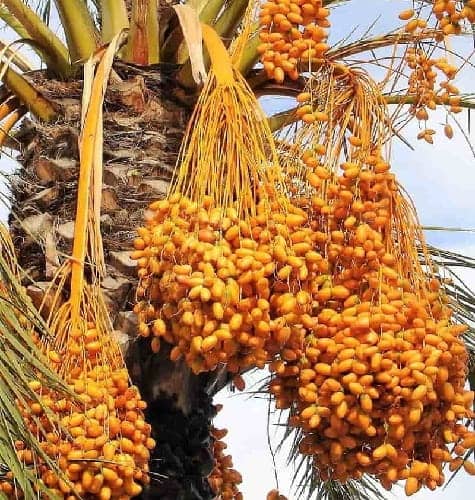 Fruits from a palm tree on the infructescence.
Fruits from a palm tree on the infructescence.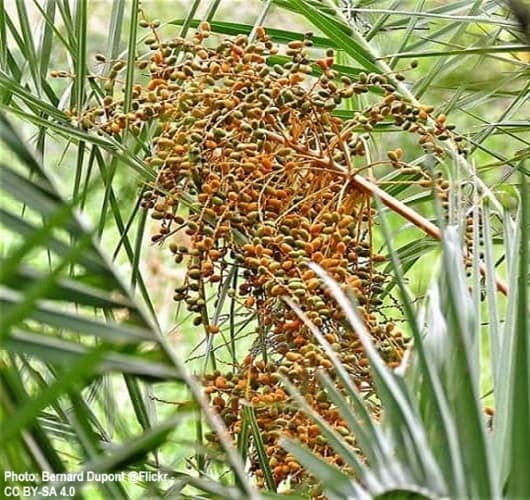 Flower blooms of the Pygmy Date Palm.
Flower blooms of the Pygmy Date Palm.Anatomy of a Palm Fruit
Fruit from palm trees comes in many shapes, sizes, and textures.
Most are "drupes" - like the Fruit of the California Fan Palm.
- With a thin outer covering (epicarp). This layer varies from smooth to prickly rough.
- Plus a hard inner shell (endocarp) protecting the seed.
- The fleshy layer (mesocarp) nurtures the developing seed.
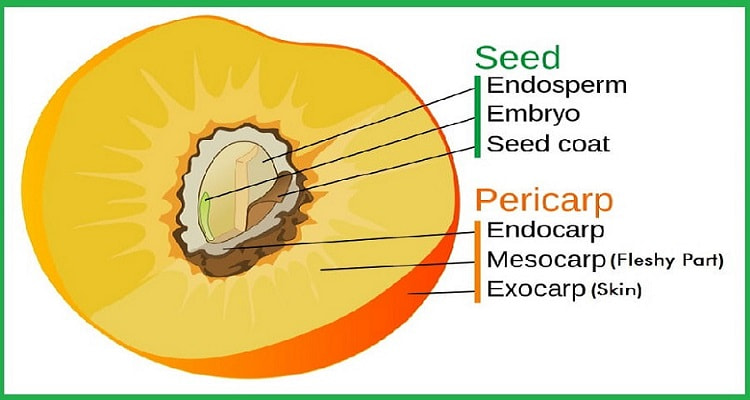
Other palm fruits are berry-like. Tiny, with a thinner skin.
No matter their form, all palm fruits share the same purpose. First to protect, and then encourage ripened seed dispersal.
Which Palm Tree Fruits Are Edible?
Some palm tree fruit is edible. For eating as is, making into jams or jellies, or incorporating into other tasty dishes. About 100 species out of the 2800/+ palm species in the world. So you can see most aren't suited as human food.
Many areas and cultures Grow Palms for their fruit. You may not have heard of many of these species of fruit from palm trees, since they don't ship them from their endemic areas.
But birds, squirrels, and other wildlife need palm fruit, essential to their diet. They spread the seeds in droppings, which provides continuing generations of palm tree lives.
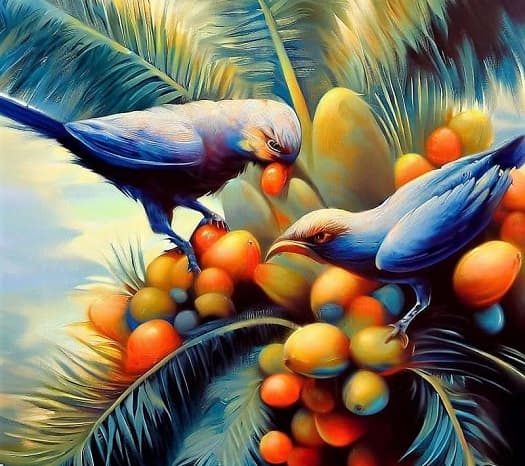 Birds like many palm tree fruits just fine!
Birds like many palm tree fruits just fine!Coconut (Cocos nucifera)
Inside a coconut lies a bonanza of tastiness and hydration. This wondrous palm tree fruit provides nourishing water, yummy meat, and multipurpose oil.
Coconut fruit is used in delish dishes & drinks.
- How about creamy Coconut Milk!
- How about that drink: piña coladas. Have you had one?
- How about its healthful benefits? A good source of healthy fats & electrolytes.
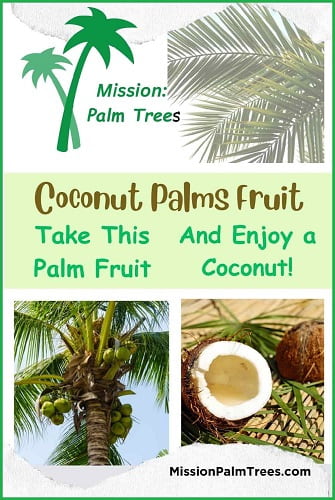
The Coconut Palm is widely cultivated, supporting economies around the world.
- Coconut fruit arrives pretty quickly on newly planted trees.
- Growing in clusters, the ripened coloring could be green, yellow or brown.
No wonder it's a staple product worldwide!
Date Palm Fruit (Phoenix dactylifera)
Commonly called the Edible Date Palm, it's native to Northern Africa & the Middle East, where they still grow.
They're sweet & chewy, usually brownish orange, about 3 inches long. The caramel-like flavor is useful in desserts or eaten as is. Also used as a natural sweetener.
- Date fruit is nutritionally wholesome.
- They're a good source of fiber, potassium & other nutrients.
Cultivated in many dry climates for over 5000 years. It naturally grows around desert oases, and alongside rivers. It's drought tolerant, but does need a nearby groundwater source.
As a valued palm fruit for food, arid areas throughout the world commercially grow them. California & Arizona are examples in the US. We've stopped in the Arizona town called Dateland a time or two.
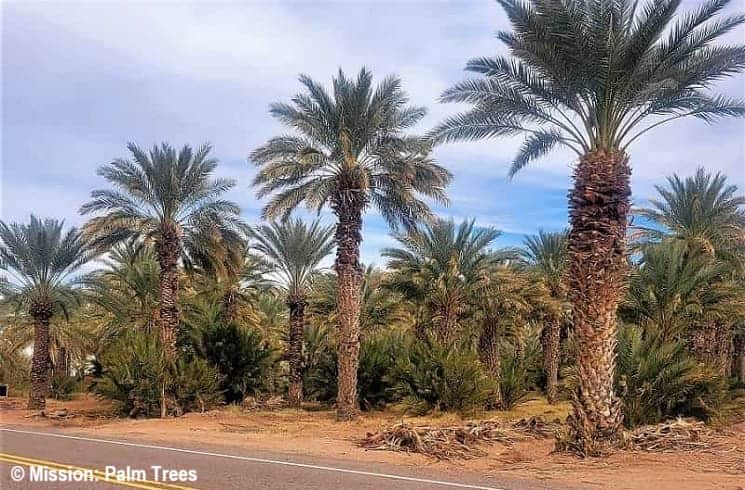 Lots of Date Palms in an Arizona town dedicated to growing them.
Lots of Date Palms in an Arizona town dedicated to growing them.Acai Berries (Euterpe oleracea)
Have you heard of the acai berry?
But first of all how is acai pronounced?
- Say it: ah-sigh-EE, you emphasize the last part.
- The fruit of the Euterpe oleracea palm.
The fruit from Acai Palm Trees have become one of the most favorable palm tree edible fruits.
Acai berries are actually drupes. Popularized as the superfood of palms. They've become popular around the world, with a unique flavor. They're native to the Amazon rainforest. Local people use fruit from the Acai palm in many of their own recipes.
Amazon has many of its "superfood" products.
- Used for acai Smoothie Bowls and Juices.
- Used for nutritional Supplements and Powders For Mixing.
- Used for Tea Infusions (which we love), a Sorbet Treat, and Puree for Your Own Creative Dishes.
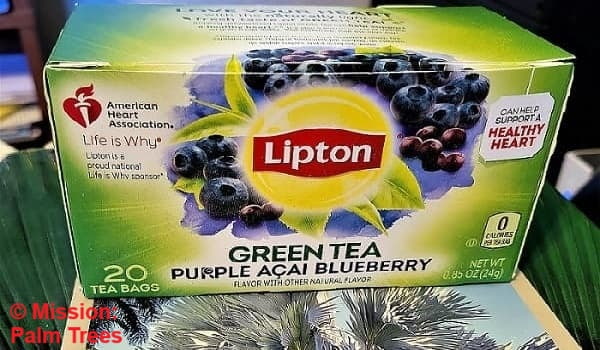 We love an afternoon pick-me-up with acai infused tea.
We love an afternoon pick-me-up with acai infused tea.Acai fruit contains Antioxidants, the main reason for being called a "Superfood."
- They possibly help with inflammation.
- They have lots of good fiber, potassium & vitamin C. With healthy fats & Phytochemicals.
- But there's no validated proof they help weight loss 😟
Once picked, these small, purplish berries are only good for about 24 hours. They must be dried or flash frozen to survive shipping.
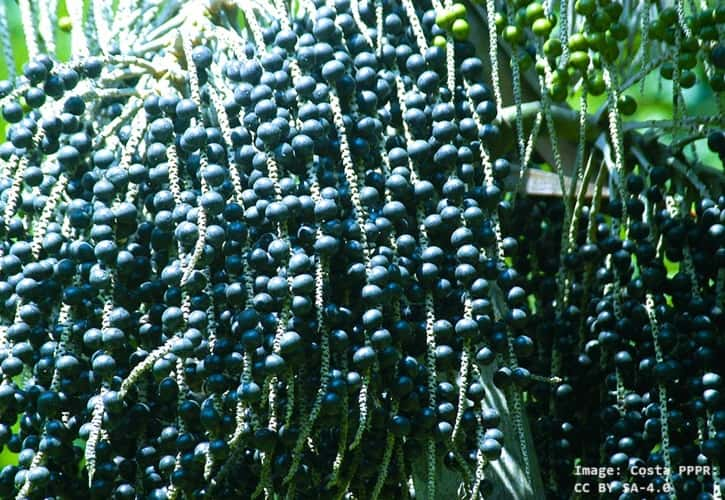 Berries ripening on the Acai Palm Tree.
Berries ripening on the Acai Palm Tree.Feeling overwhelmed by so many palm trees?
You're not alone. We Understand your headaches! At Mission: Palm Trees you'll find clear answers to questions & Step-By-Step Guidance, from real people. With solutions to help. No puzzling shoptalk. No tiring research. So it's easy & fun for you.
Peach Palm Fruit (Bactris gasipaes)
Surely sounds like a palm tree with yummy fruit! Is it?
Bactris gasipaes is found from Central to South America, where it's a food staple. Fruits are orange, yellow or red.
- The fruit is locally called Chontaduro. Often eaten right off the palm.
- They have a potato-like consistency.
- Growers even developed a seedless version.
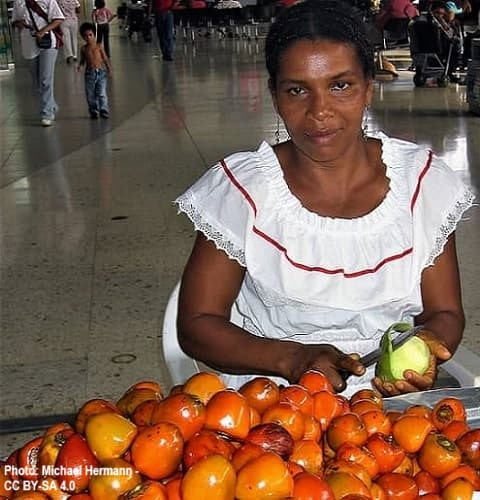 Woman Prepares Orange Peach Palm Fruit in Colombia
Woman Prepares Orange Peach Palm Fruit in ColombiaChilean Wine Palm Fruit (Jubaea chilensis)
Jubaea chilensis originated in Chile's savannahs and lower Andes' foothills. Fruits are tiny and round. May be yellow, orange or something in between.
- It became endangered because the sap's been used for wine production. Palms were cut down for the process. Now they're protected.
- If you have a chance to sample one, drill down to the seed, that's delish! Having a coconutty taste.
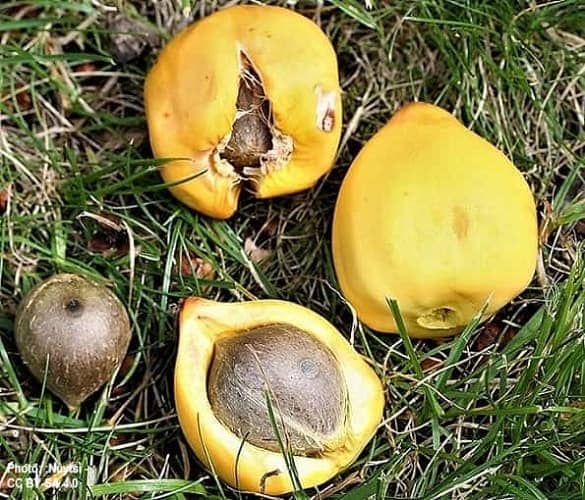 Jubaea chilensis Fruit Inner Nut of Chilean Wine Palm Fruit
Jubaea chilensis Fruit Inner Nut of Chilean Wine Palm FruitAt Royal Tasmanian Botanical Gardens
Moriche Palm - The Swamp Dweller
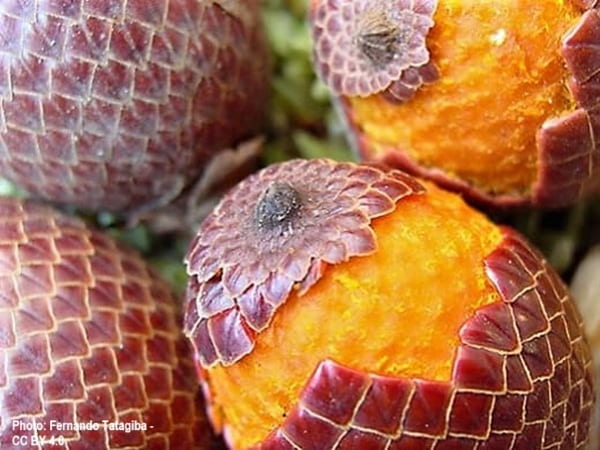 Close-up look of ripe, Moriche Palm fruits - Looks delish?
Close-up look of ripe, Moriche Palm fruits - Looks delish?The moriche (Mauritia flexuosa) loves steamy, Amazonia's swamplands.
Hogging up areas where it grows. Its edible palm fruits are regionally popular.
- A typical fruit is three inches, kind-of egg-shaped. With a scaly skin.
- People eat the dark red, ripened fruits right off the palm tree.
- Locals make the fruits into flour. Or express the oil for cooking. Or ferment the fruit for a tipsy style drink!
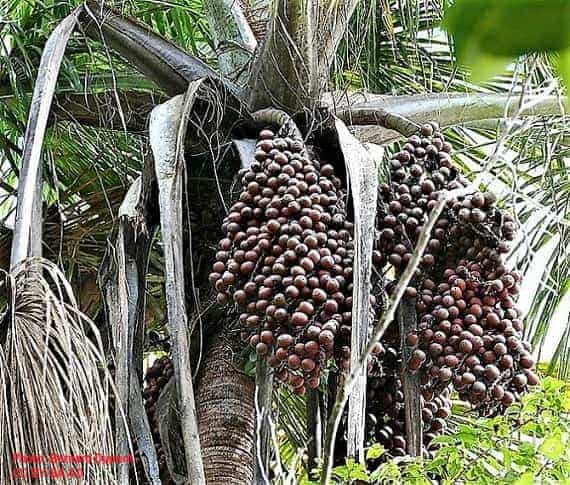 The Edible Fruit of the Moriche Palm
The Edible Fruit of the Moriche PalmRed Salak Fruit is Highly Favored
Salacca affinis is from the islands of Southeast Asia.
Likes swampy rain forests.
- It has locally eaten, teardrop shaped, red fruits.
- In Thailand it's called Luk sala, or written in Thai: ลูกสละ. You may hear it called Snake Fruit.
- Some say it tastes kind of sour. Others think it's like a smoothie with dried bananas & dates mashed with jackfruit.
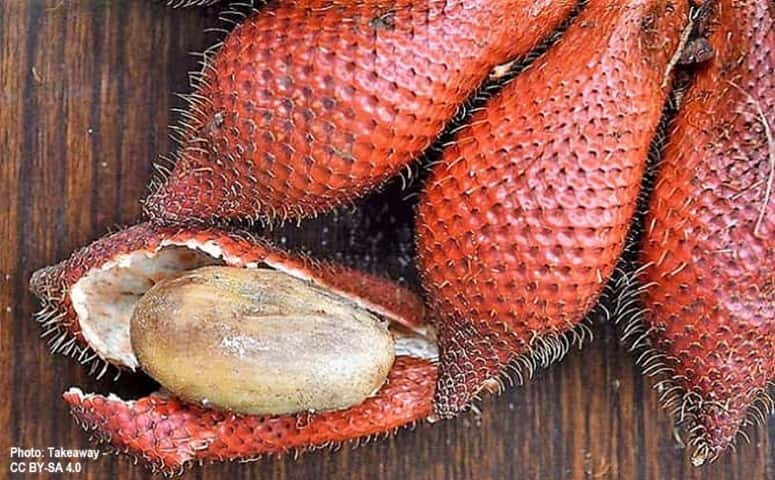 What Do You Think About Trying Snake Fruit?
What Do You Think About Trying Snake Fruit?Vegetable Ivory Palm Fruit
Hyphaene petersiana is native to central areas of Southern Africa. It can grow quickly.
- People like its sweet fruit. After getting rid of the prickly outer shell!
- Other Palm Parts are useful locally.
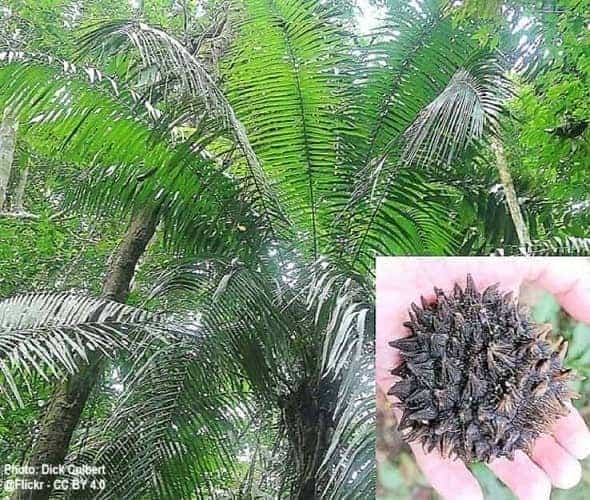 Vegetable Ivory Palm has some good fruit inside that prickly shell!
Vegetable Ivory Palm has some good fruit inside that prickly shell!Questionably Edible Palm Fruits
Some palm tree fruits aren't popularly eaten by humans. Some can technically be eaten, but aren’t tasty or common. Their value is typically useful as animal feed.
Like the Fruit of the California Fan Palm. Which has been traditionally eaten and used for flour/oil.
You could try them out if you'd want. Some are eaten, by having an experimental outlook and possibly getting that acquired taste.
Macaw Palm Fruit (Acrocomia aculeata)
Also known as Macaúba. The Acrocomia aculeata has fibrous fruit. Found in Mexico, the Caribbean & areas of South America.
- People have been known to eat the sweet pulp. But they find it more useful for the oil.
- This palm's fruit is primarily given over to feed animals.
- Stories from Panama tell about making this palm tree's sap into an alcoholic drink that will zap your wild disposition into gear!
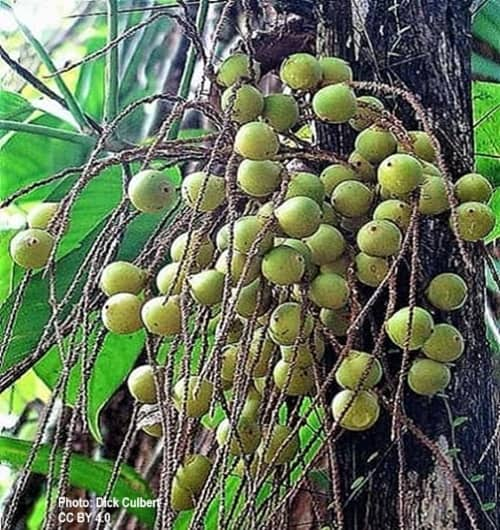 Acrocomia aculeata With Still Unripe Grugu Nuts
Acrocomia aculeata With Still Unripe Grugu NutsCanary Island Date Palm Fruit (Phoenix canariensis)
Phoenix canariensis originated on the Canary Islands - think you figured that!
At full growth, this palm tree is massive.
- It produces oval-shaped almost dayglo orange fruit.
- They're technically okay to eat. But would you want to? Their taste isn't very tasty!
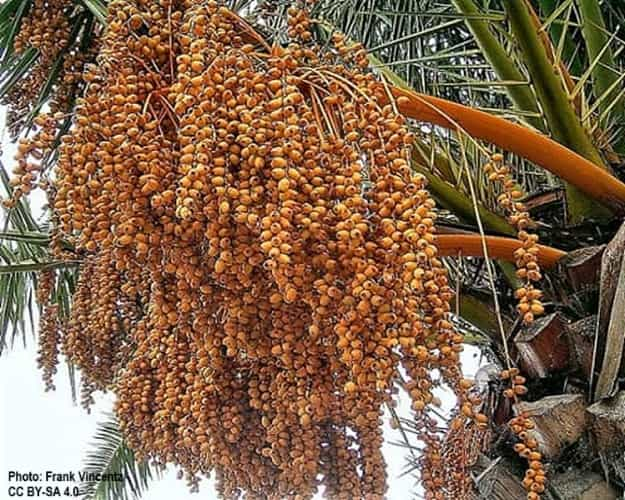 Fruit in Abundance on the Phoenix canariensis Palm
Fruit in Abundance on the Phoenix canariensis Palm- Another palm part that's there to produce fruit, gives something tasty! Newly grown inflorescences (flower stalks) ooze sap. That's transformed to honey.
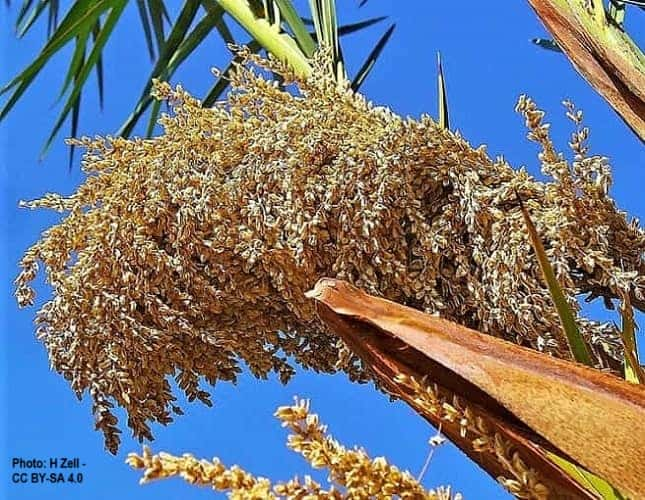 Flowering Inflorescences on the Canary Island Date Palm
Flowering Inflorescences on the Canary Island Date PalmAfrican Wild Date Palm Fruit (Phoenix reclinata)
Locals sometimes eat this palm's fruit.
Probably it's an acquired taste! Phoenix reclinata is also called Senegal Date Palm. Growing in Africa, especially on riversides.
- Brownish oval fruits are under one inch long.
- The inner seeds are ground into flour.
 Wild Date Palm Fruits at Skukuza Nursery Kruger NP
Wild Date Palm Fruits at Skukuza Nursery Kruger NPCherry Palm is Natively Endangered
Also called Wine Palm, the Pseudophoenix vinifera is sadly endangered within its original indigenous source, on Hispaniola.
Since this palm has been constantly cut. To use sap for wine production.
- Fruits are distinctive, brilliantly red in a long inflorescence. From 1-2 inches & round.
- But don't think you'd want a taste - yuk!
- Instead they're fed to domestic animals.
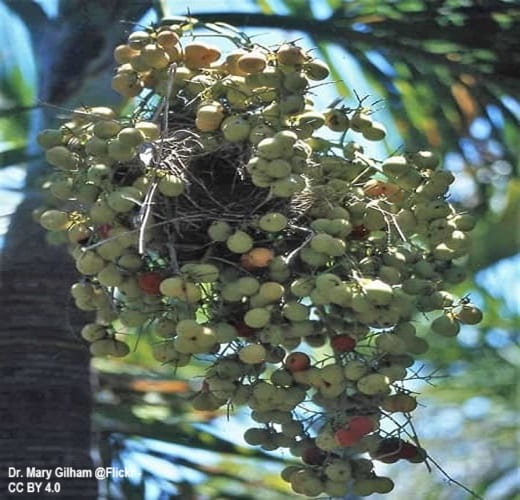 Wine Palm Fruit
Wine Palm FruitThe Latest Here...
-
Backyard Palm Tree Ideas Make Your Space Feel Like a Tropical Escape
Bring a resort feel home. Explore inspiring backyard palm tree ideas with themes like clustering, layering, and lighting designs for any space. -
Palm Tree News for Fun Facts Fans Want to Know!
Palm Tree News gives this beloved plant its deserved attention! There's more to them than their aesthetic appeal. See the surprising facts.
Rare or Unusual Palm Fruits
Double Coconut (Lodoicea maldivica)
These palm tree fruits are huge! Resembling two coconuts hooked together. Native to two islands of the Seychelles.
- They take up to seven years to ripen.
- What's valued is the humungous inner seeds, the largest seed on earth!
- With gargantuan legends attached!!
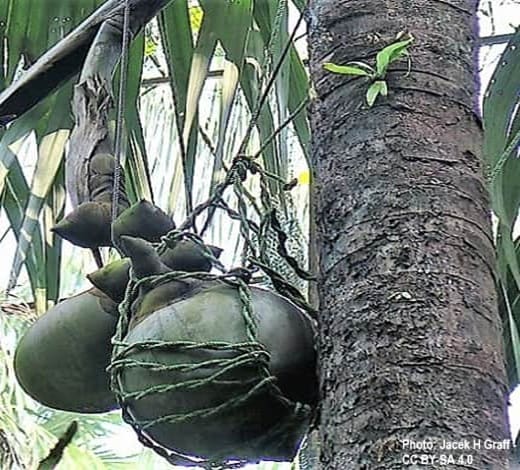 On an Estate, They've Rigged Holders For Protection
On an Estate, They've Rigged Holders For Protection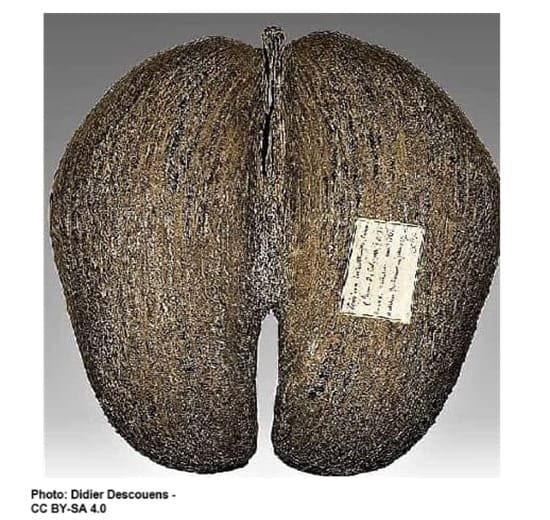 So Strange They Put It in a Collection at Museum de Toulouse
So Strange They Put It in a Collection at Museum de ToulouseBetel Nut (Areca catechu)
Are there health risks to using it?
This palm tree's fruit produces a stimulant. Coming from the Areca Palm (Areca catechu), it's sometimes called the areca nut.
It's used by people specifically for the energy boost it causes. It speeds up the central nervous system because some of its ingredients causing an adrenaline release.
Commonly chewed in areas of Asia, the Pacific Islands & East Africa. Long-term users can be spotted by their purplish tinted teeth.
It can even cause tooth loss & is reportedly a carcinogen.
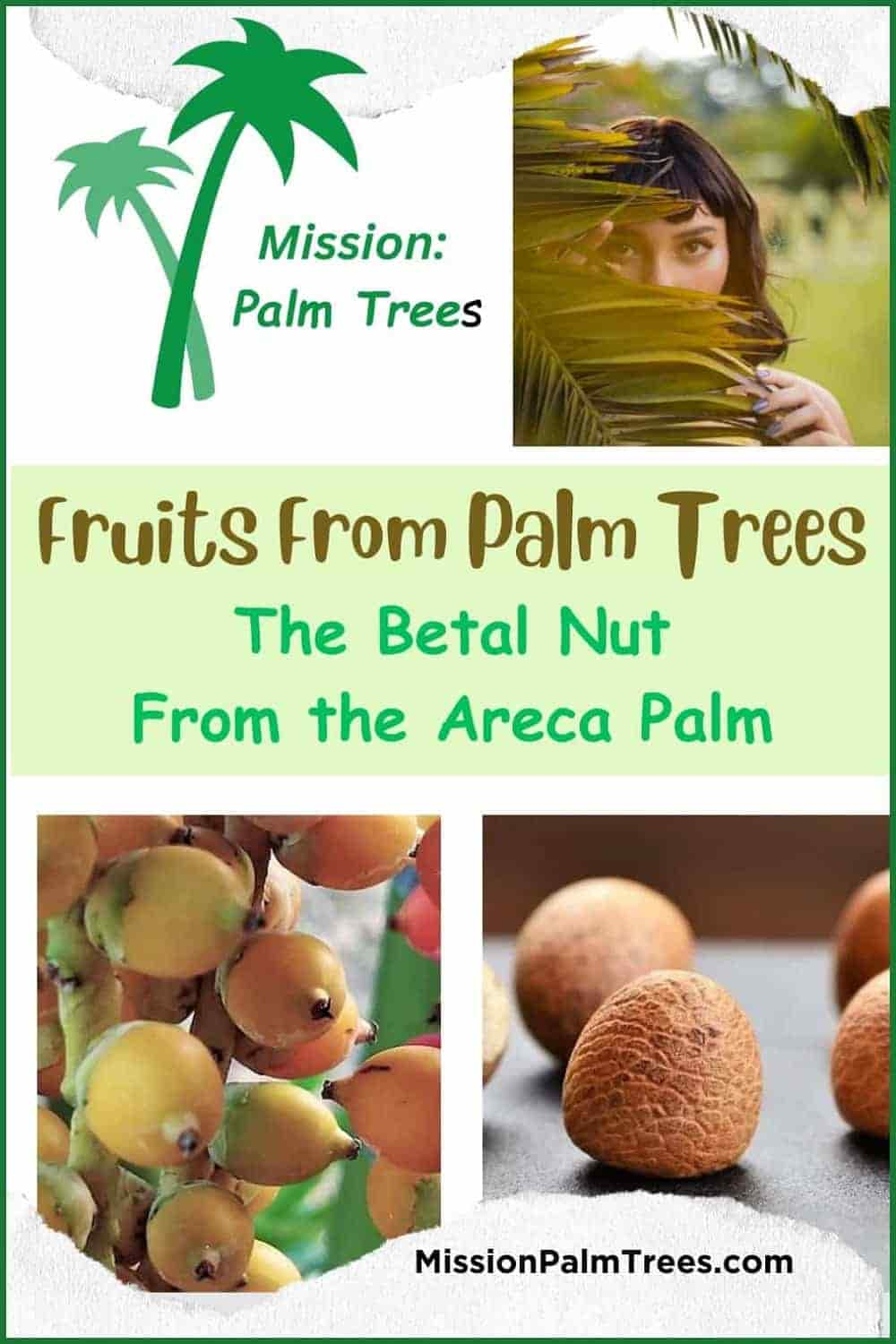
Ubussu Palm or Yolillo Palm
Manicaria saccifera fruits become a refreshing, nourishing drink. Or even a cough syrup.
From areas in Central & South America.
- The look is different. With triangular scales & curly spurs.
- They often drop & roll into nearby flowing waters.
- When they come ashore, sprouting can begin.
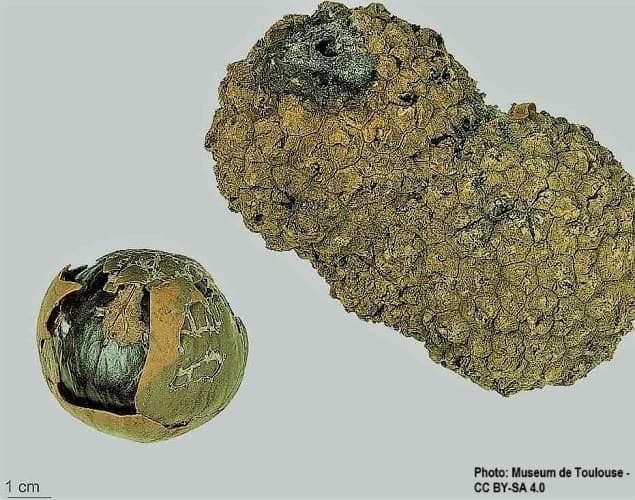 Museum de Toulouse specimen photo helps evaluate Ubussu fruit's size.
Museum de Toulouse specimen photo helps evaluate Ubussu fruit's size.Other Palm Fruits Worth Knowing
Palmyra Palm Fruit is Sweetly Useful
The Doub Palm or Palmyra Palm has even more common names!
Borassus flabellifer is a Native Palm Tree in South & Southeast Asia. Its palmyra fruit is a popular ingredient in South Asian cuisine. It has sweet, jelly-like flesh.
BE CAREFUL WITH THE KNIFE!
Still a Few More to Consider
Many other palm fruits have their own unique flavor & possible culinary uses. Varied locally. Some examples are:
- Orange Palm Tree Fruit - From the Butia capitata palm, producing a Jelly Palm Fruit.
- Fan Palm Tree Fruit - Which includes two types of fruits from fan palm trees
- Washingtonia robusta - The fruit from palm trees of this species can be freshly eaten, or dried.
- California Fan Palm Fruit - from the Washingtonia filifera palm.
FAQ for Fruit from Palm Trees
Can you eat fruit from all palm trees?
Can you eat fruit from all palm trees?
No is the simple answer.
Out of 2,800+ palm species, only about 100 produce edible fruits for humans. Most palm fruits are bitter and not useful as human food. Many others can be useful food for wildlife or farmed animals.
Which palm fruit is the most popular worldwide for eating by people?
Which palm fruit is the most popular worldwide for eating by people?
Coconuts are the most widely used edible palm fruit, followed by dates. Both are staples in diets and help provide for economies worldwide.
Are palm fruits healthy?
Are palm fruits healthy?
Yes.
Many edible palm fruits, like coconuts, dates, and acai berries, are rich in fiber, healthy fats, essential vitamins and antioxidants.
What type of fruit is a palm fruit?
What type of fruit is a palm fruit?
Most palm fruits are classified as drupes — fruits with a fleshy outer layer and a hard inner shell protecting the seed. Some small fruits are referred to as berries.
Takeaways for Fruit From Palm Trees
Now you've seen the wide variety of fruits from palm trees. The next time you're looking to try something new & unique, you might think of the edible fruits we've shown you.
We'd be quite interested in discovering which you've tried. And how it was prepared for eating. You can do that by Posting It On Our Facebook Page!






